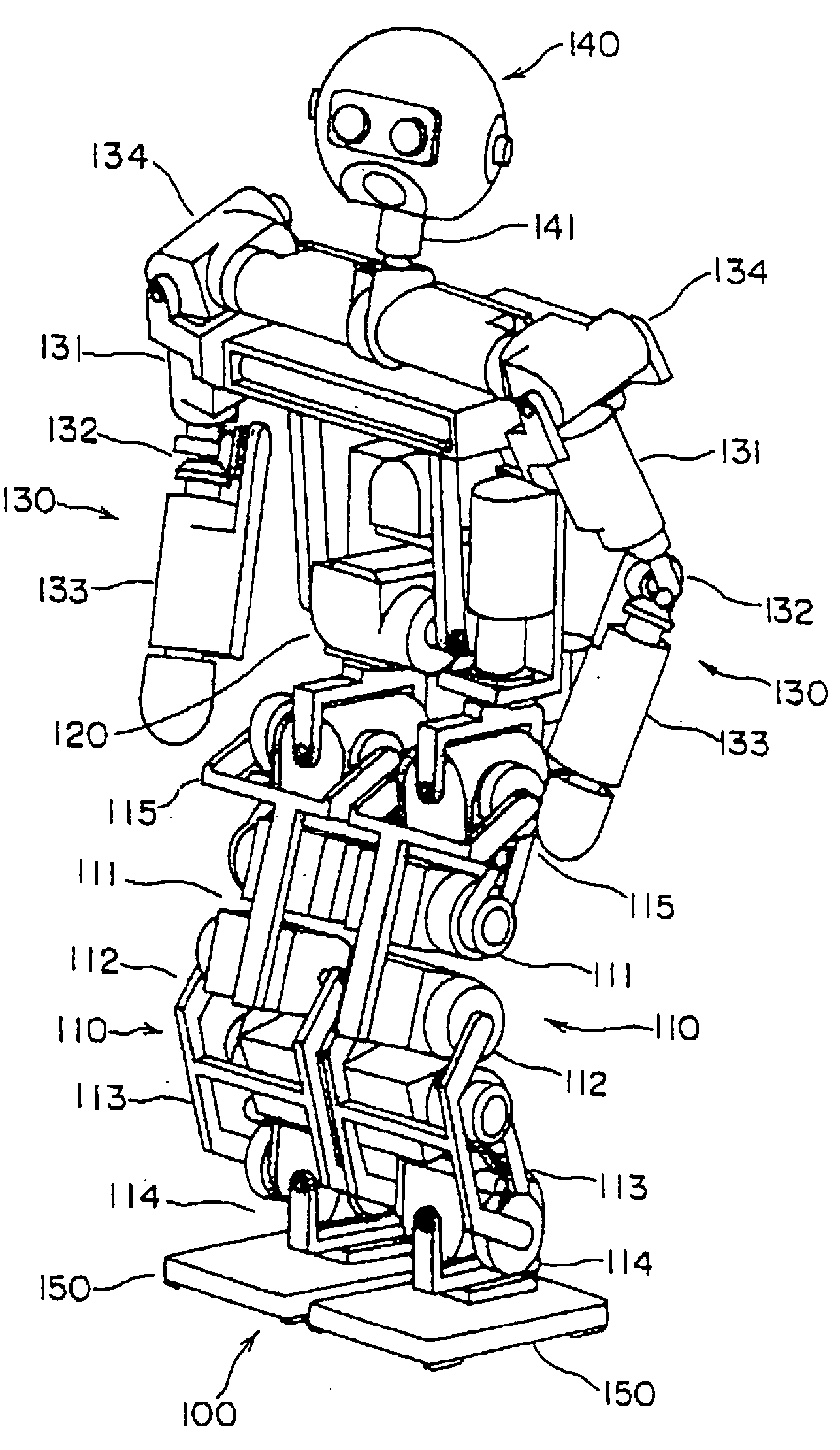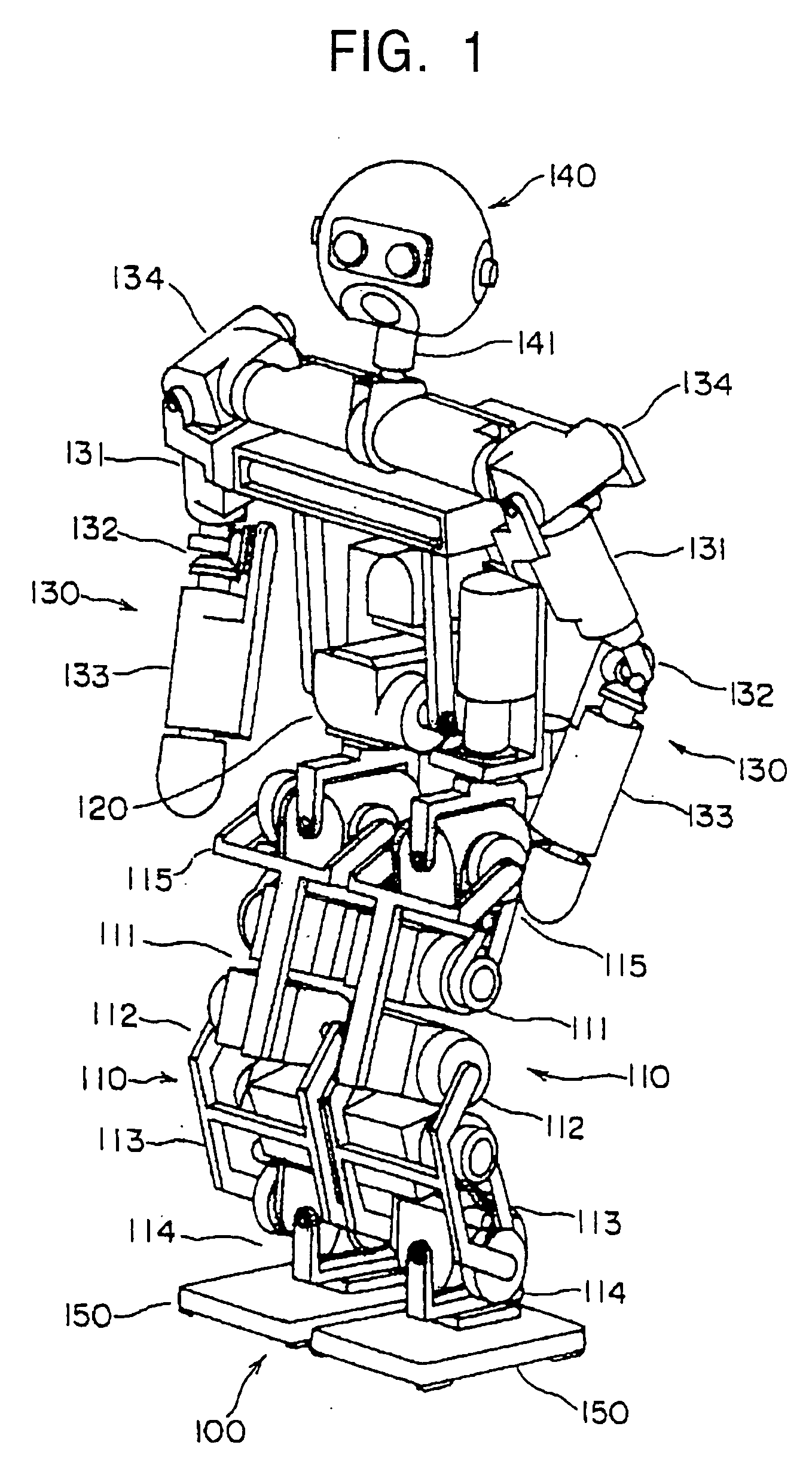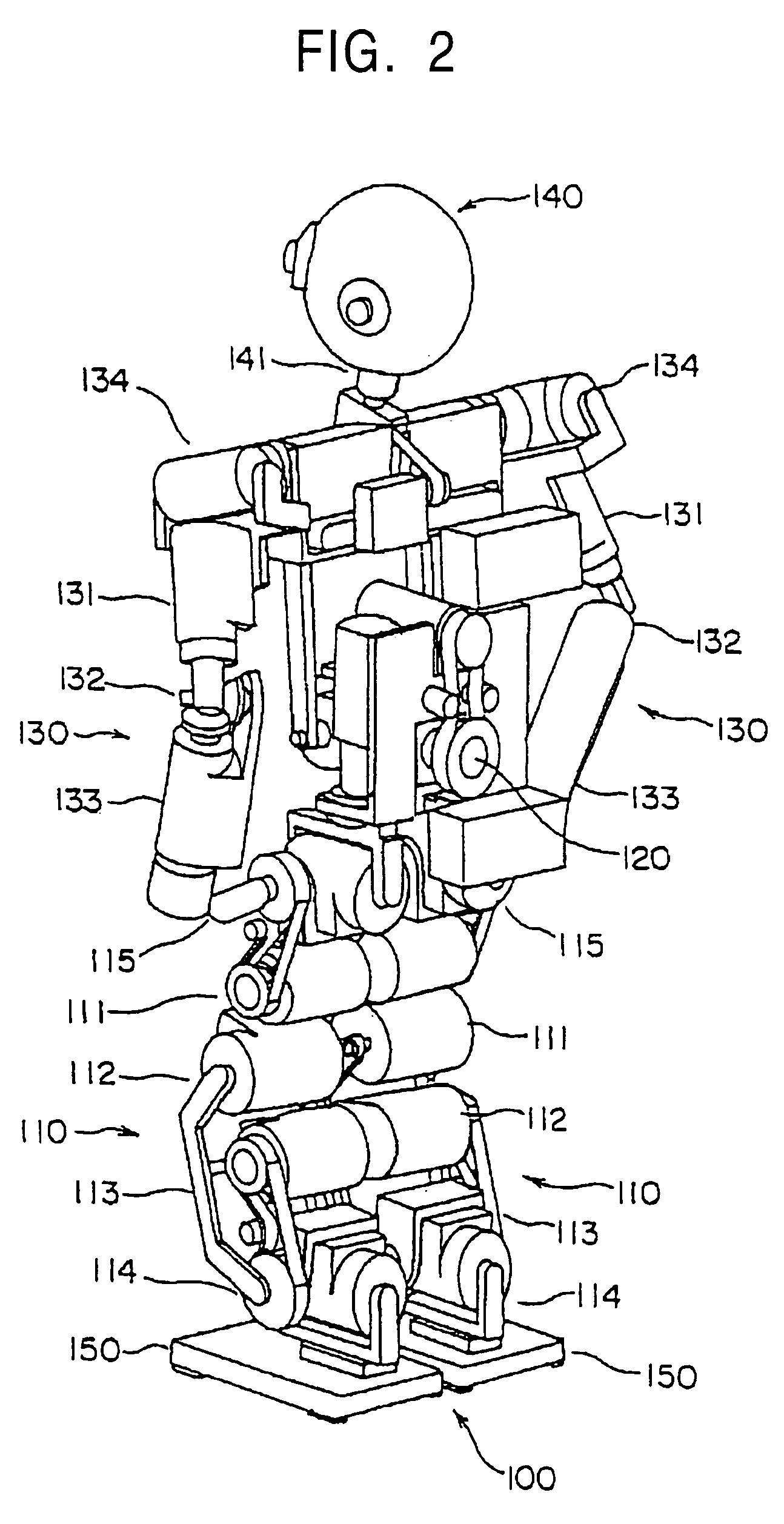The legged mobile robots which walk upright on two feet are unstable compared to crawler-type, four-legged, and six-legged robots, and have a
disadvantage in that
attitude control and walking control thereof are complex.
As a result, there are so many barriers for present mechanical systems using wheels or other driving devices as moving means to move in living spaces of human beings.
In such a case, there is a problem in that the contact area between the foot 910 and the
road surface 911 decreases and the resistive force against the moment around the
yaw axis also decreases.
As a result, the attitude of the
robot becomes unstable.
The reduction in the
attitude stability is not only caused by the deflection of the foot sole.
Also in the case in which a bump is positioned under the central area of the foot bottom surface when the foot sole is placed on the
road surface, the foot falls into a so-called seesaw state and a similar problem occurs.
In addition, since no consideration is made on the corners and side edges of the foot bottom surface, that is, a ground-contact surface of the foot sole, if the road surface has bumps and depressions, the corners and side edges may interfere with the road surface with bumps and depressions when the idling leg is placed thereon, and this may cause the
robot to stumble.
In addition, the
robot may fall into a so-called stick-slip state where the robot repeatedly stumbles and recovers.
As a result, the upper body of the robot may loose balance and the attitude of the robot may become unstable.
Accordingly, the resistance against the moment about the
yaw axis generated due to the motion of the legged mobile robot decreases and the attitude of the legged mobile robot becomes unstable.
In addition, the change in the shape of the resistive-force-generation
effective surface may cause an unexpected change in the behavior of the legged mobile robot, which leads to the reduction in the
attitude stability of the legged mobile robot.
However, it is to be noted that the actual walking surfaces include continuous, swelling surfaces and discontinuous surfaces such as surfaces with bumps and depressions or steps, and these surfaces are also the cause of the reduction in the attitude stability of the legged mobile robots.
As a result, the behavior of the foot becomes nonlinear and its control becomes extremely difficult.
In addition, the motion trajectory becomes unstable, and correction control and a movement plan must be reset.
In addition, when the foot is placed on a delicate, slippery surface, such as a carpet, as shown in FIG. 86, there is a high possibility that the ground-contact surface of the foot will slip and the motion stability of the legged mobile robot will decrease considerably.
In addition, when the foot is placed on a surface with high friction or a soft surface which easily catches the foot, as shown in FIG. 87, falling moment is generated due to the inertial force, etc., when the
surface pressure, which depends on the shape of the ground-contact surface of the foot, or friction in the planar direction excessively increases.
In addition, when the foot is placed on a step, as shown in FIG. 88, in addition to the problem of the support moment described above with reference to FIG. 85, there is also a problem in that the foot may slide down when conditions of the shape of the step, or a bump, are not good or when the friction is extremely low.
In addition, since such a motion is extremely fast compared to control cycles, there is a risk that suitable countermeasures cannot be implemented.
However, in this structure, the
plantar arch comes into contact with the edge of the step or the bump such that a resistive-force-generation
effective surface 921 has a triangular shape, as shown by the hatched area in the figure, and conditions for ensuring the stability become severe.
Generally, it is extremely difficult to predict how this rotating motion occurs.
As described above, in the known foot structures, the attitude of the robot in the falling motion is not constant, and is difficult to predict.
Therefore, once the falling motion starts, it is difficult to implement controls related to the falling motion, for example, control to avoid falling over, control to reduce the
impact of falling over, control to recover from falling over, etc.
Accordingly, the robot cannot help but fall over, and it is difficult to cause the robot to recover by itself.
Accordingly, there is a problem in that the cost of the robot increases.
In addition, the legged mobile robots are currently moving from the research stage to practical application, and there are still many technical problems which must be solved.
For example, although the state of the road surface (whether or not it is rough, the
coefficient of friction thereof, etc.) has a large influence on the attitude stability control in legged walking motion and stable walking, this is not fully understood.
With respect to the walking stability of the robots, although the robots are required to walk on various kinds of road surfaces similarly to human beings, it is difficult for the robots to perform various walking motions similarly to human beings.
In comparison, when a small, light robot walks on the same carpet, a pressure applied to the surface of the carpet by a foot sole of the robot is small, and the surface of the carpet cannot be sufficiently pressed at a region where the foot is placed.
It is difficult for the robots to perform various walking patterns like human beings, and the robots cannot easily adapt themselves to the road surface on which they are walking.
Although the foot and the foot sole of the robots are widely researched and developed, it is currently difficult to obtain a perfect foot which can be adapted to any type of road surface from a both technical and financial point of view.
This leads to a difficult problem if a sufficiently large space cannot be provided for accommodating the ROMs as in small legged mobile robots, and high costs are incurred if a large-capacity ROM is used.
In addition, it is cumbersome for the user to input the above-described identification information each time the foot or the foot sole is replaced.
More specifically, when the road surface has bumps and depressions, a part of the foot may interfere with the surface with bumps and depressions (be caught by the surface or stumble thereon) when an idling leg is placed on the road surface, and there is a risk that the upper body of the robot will lose balance and the attitude thereof will become unstable.
This problem becomes more severe when a high-speed motion is performed since the reaction force from the road surface increases.
However, since the main controller of the robot's main body directly receives the outputs from the sensors mounted on the foot and performs necessary calculation processes including the ZMP calculation, there is a problem in that a large
processing load is placed on the main controller.
More specifically, a computing unit of the main controller which is mounted in the robot's main body performs complex and enormous calculations for, for example, setting the motion of the robot.
In addition, in order to supply the outputs from the sensors provided on each foot to the main controller of the robot's main body, complex wiring is necessary to connect the sensors and the main controller.
In such a case, there is a problem in that a large
workload is required for replacing the foot.
 Login to View More
Login to View More  Login to View More
Login to View More 


